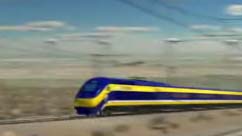
1A |
|||||
PROP 1A |
|
In 1996 the California High-Speed Rail authority was created to plan and build an electric-powered, high-speed rail system linking California's major cities. The Rail Authority estimates that the total cost to finish planning and then build the entire system is about $45 billion. |
 |
What Prop 1A would do if it passes:Allow the state to sell $9.95 billion in bond to continue planning and start building the high-speed rail system. About $9 billion of this would be used to start the core route between San Francisco and Los Angeles/Anaheim and possible extensions. The remaining $950 million would be spent on local and other state rail systems. Fiscal effect on government:State costs of about 19.4 billion over 30 years to pay off the bonds plus interest. Payments would average $647 million per year. State costs of about $1 billion a year to run the high-speed rail system. These costs would be partly offset by train ticket sales. |
|
The 800-mile system would resemble the letter "Y," with a long tail, placed in the center of the state. The initial line would start in San Francisco, head down the Peninsula along the Caltrain right-of-way with stops in Millbrae, Palo Alto, San Jose and Gilroy. It would zip across the Pacheco Pass to the San Joaquin Valley, stopping in Fresno and Bakersfield, with a possible station in Visalia. It then would bypass the Grapevine, heading instead to Palmdale with stops in Sylmar and Burbank before reaching Los Angeles and, possibly, Anaheim and Norwalk. Extensions are planned to Irvine, to San Diego through Riverside County and to Sacramento. |
To see an interactive map of the proposed route: And here's a debate on Prop 1 from the San Francisco Bay Guardian. |
Pro |
Rod Diridon, of the High-Speed Rail Authority says: high and higher-in-the-future gas prices, the growing concern for global warming, the terrible condition of our highways, and compounding that is the congestion coming in and out of our metro areas. Those four factors make a perfect case for high-speed rail. On the one hand, we could hope that by spending billions each year on roads and highways, we will meet our transportation needs. But California’s dependence on cars comes with high costs for our health and quality of life. Commuters in California’s biggest cities spend an additional 60-70 hours behind the wheel each year due to traffic congestion. What’s more, forty-one percent of California’s global warming pollution comes from cars. Even as we develop cleaner fuels, current projections for growing car and airline travel will make it difficult to meet our state’s commitments to reducing global warming pollution. High speed rail will allow Californians to travel from the Bay Area to Los Angeles in two and a half hours, without the hassle of the airport. High speed rail is predicted to take up to 92 million drivers off the road annually and attract 18 million travelers who would otherwise fly. "With our population expected to hit 50 million by 2030, people will need either more highways and airports - or they could use high-speed rail," said Kevin Powers, field organizer for the CalPIRG, a consumer group pushing for a fast-train network. "High-speed rail is cheaper to build, faster to ride and far less polluting than the alternatives." Proposition 1A is $9.95 billion bond measure that would help fund construction of a world-class high-speed rail system linking northern and southern California by way of the Central Valley. Replacing car and plane trips with electrified train travel is an essential part of California's efforts to reduce global warming pollution, and Los Angeles to San Francisco is the most highly trafficked air corridor in the world. High-speed rail would provide an alternative to air travel that would allow people to make the trip in under three hours. Prop 1A also would create hundreds of thousands of green-collar jobs in both the construction and operation of the system. The alternative to high-speed rail -- more highways and expanded airports -- is not only more expensive, but would increase pollution. Finally, the new high-speed rail system would link to commuter and regional rail lines, giving Californians more transportation options. From the National Resources Defense Council |
Con |
We believe that the development of this project will be a financial disaster for all Californians, except those who stand to profit mightily from the anticipated largesse of state, federal and private funding. Construction and land acquisition cost will certainly rise if delayed. Unfortunately, it sounds like the route is being gerry-mandered to include too many stops. Five stops between San Francisco and San Jose is too many; that's what local service is for. There is no guarantee this high-speed rail system will ever be finished. From the Santa Cruz Sentinel: Menlo Park and Atherton have plans to sue the CHSR Authority. They say that the route through those towns would serve fewer riders and be far more environmentally damaging than the Altamont Pass route. Under the Altamont Pass route, trains would continue north from Sacramento into the San Joaquin Valley before heading west, bypassing those peninsula towns. High-speed rail through Altamont would reduce congestion on Northern California's most gridlocked stretch of highway. Altamont would reinforce development of existing centers like Livermore, Tracy, Stockton and Modesto with smart growth. Altamont would also connect existing jobs and housing by providing an improved route for fast regional service as well as high-speed trains. |